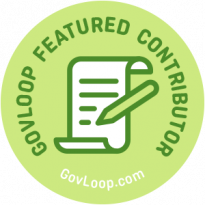True story: I was at a meeting with a team made up of senior executives seated around a conference table. They were discussing the various screens and fields a user would click through to enter data in a new application they were going to deploy agencywide. When we were out in the hallway during a break, I asked one of the senior members of the team were any of the people at the table going to be users of this app, and he said “no.” “Have you asked any prospective users of this app what they think of the interface?” I inquired. And he replied (I am not kidding here): “No, do you think we should?”

Another story: A few weeks ago, I was sitting with a client who was worried. Her organization had just rolled out a new digital application and scheduled user training. The problem was, not a lot of people were registering, and many who were registering weren’t showing up. This of course was causing a delay in full deployment across the organization. “They are so resistant to this change,” the client declared to me about the user community, “and I just don’t know why.” “Have you asked them why?” I queried. “No, we haven’t done that,” she replied. “Well, has anyone on your team possibly talked to the users who are coming to the training to see what prompted them to come or perhaps to see if they were glad they came?” “No, we didn’t think to do that either.”
Ask — don’t tell! Now I realize that asking stakeholders what they think seems like a simple enough strategy to diagnose a problem, but truthfully, it’s totally human to get so caught up in — or perhaps seduced by — a new solution or process or fix that leaders can forget to engage early and often with those most affected by the change they are implementing. Yet, one of the most powerful — and least costly — ways to mitigate resistance and frankly make user-friendly adjustments to new IT implementations or any other change, for that matter, is to get stakeholder input early (and often) in order to hear what people (for instance, those who will actually use the new solution) have to say about their experience of the change that is in progress.
Push communication isn’t enough. A lot of very good advice from change management consultants often comes in the form of telling people about the change. Leaders are exhorted to talk to their teams about what is going to change and why. They are urged to get their people “change ready” and make sure everyone is on board and understands “the business case” for the change. Create FAQs. Send email blasts. Put up a SharePoint site and update relevant content with information about what is going to occur so that everyone is informed and knows what’s going on. Make no mistake: These are definitely necessary best practice activities that MUST be done. But these are all “push” communications — in other words they are one-way (typically top down) — and push is never enough.
Pull — don’t just push: The other side of push communications is “pull”, which literally means pull in feedback from diverse quarters and from as close to the frontline as you can. Have conversations. Dialogues. Sit-downs with mid-level managers, team leads, and customer-facing staff. Conduct a listening tour. Consider conducting interviews and focus groups to elicit unvarnished (conceivably previously unsurfaced) observations and insights that can only come from people who are in the trenches day-to-day. Their inputs are golden. Here are just a few reasons why asking what people think works:
- You build energy. Organizations are living, breathing entities that come alive with the dynamic flow of two-way communication. Asking people what they think enriches the change process with ideas, new information, creative problem-solving, and alternative perspectives. Asking for input helps us test our thinking so we can see what will actually work in real life — not “just” in theory or in our heads.
- You build confidence in the change process. People like it when you ask them what they think and how they feel about something that will impact them and their jobs — at any level, whether it is colleagues on your leadership team for example, midlevel managers, or front-line customer-facing staff. Most people right out of the gate just want to “get heard” — and so just asking me what I think or how I feel goes a really long way, even if nothing changes as a result — as long as you are honest with me and explain to me why that is. And, of course, the whole point of asking me is that I am quite likely to have input that can positively influence the change process and its outcome(s).
- You build credibility as a leader (and leadership team). Asking me what I think says you respect me, and that you value what I bring to the table — indeed that there is room for me at the table. It means I matter. The more I feel like my leadership genuinely wants to hear what I have to say, the more likely I am to trust my leadership team — even if I happen not to be happy with the change that is occurring.
- You build investment — i.e., ownership in the change process. This helps to reduce resistance, opens the door to learning, and speeds the pace of adoption — and the promise of success.
Who is at the table? As you plan your change effort, consider asking yourself: Who do we need to hear from to think this through? Whose perspectives do we need? Are the people who will be most affected by the change engaged in the change process? Who’s missing? Is our “table” big enough or should we expand it to involve others who can provide counterpoint and challenge our thinking as we move ahead?
Thanking people inspires people! As you communicate about the change and the course of its progress over time, be sure to acknowledge colleagues and stakeholders whom you’ve asked for input. Thank them for contributing to and being part of the change process. Spotlight their contribution by broadly acknowledging their involvement. Doing so lets them know you see them and can inspire others to share their viewpoints too.
Nina is a change management practitioner and principal of InterrogativesWork, LLC, a change advisory service dedicated to helping clients and consultants plan and implement organizational change. She has supported a wide variety of organizational change and strategy efforts — from digital transformations and functional re-alignments to the stand-up of enterprise risk management programs, PMOs, organization-wide policy and culture change, performance improvement initiatives, and more. She has an MA in Communications and an MS in Organization Development and graduated from both the Johns Hopkins Fellows in Change Management Program and Georgetown University’s McDonough School’s Change Management Advanced Practitioner Program (CMAP). She is ProSci trained, and has written about organizational change for govloop.com, Change Management Review, and Government Executive.
Image courtesy of pixabay.com





Leave a Reply
You must be logged in to post a comment.